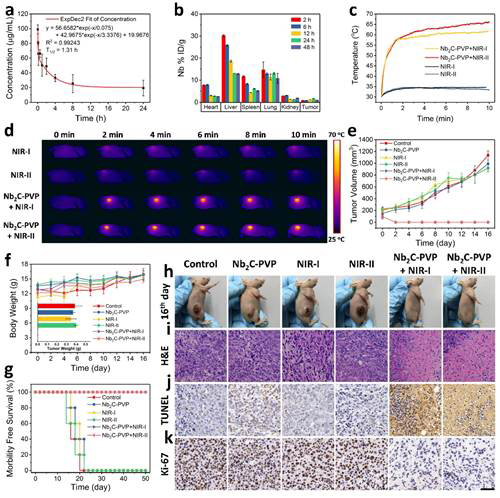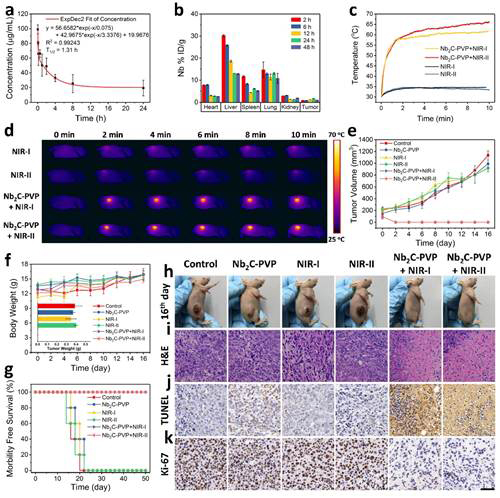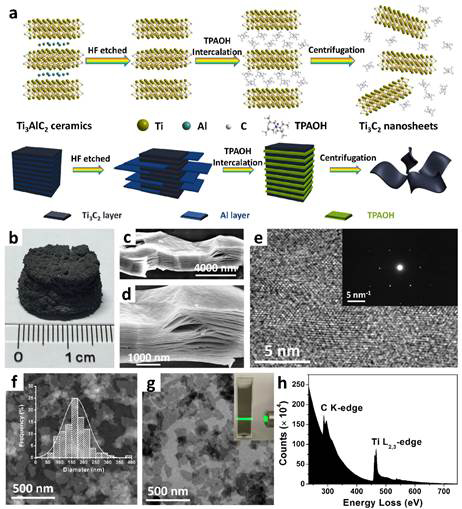
Recently, a research team led by Researcher Chen Yu and Researcher Shi Jianlin of Shanghai Institute of Ceramics, Chinese Academy of Sciences (mesopore and low-dimensional nanomaterials research group) carried out various types of controlled synthesis of 2D MXene and biomedical applications for tumor diagnosis The systematic research work related to the enzymatic degradation of MXene itself, the phagocytosis behavior of MXene in vitro and in vivo, the response to multi-region near-infrared light, efficient photothermal tumor treatment, diagnostic imaging, and systematic biosafety evaluation. Relevant research results were published in J. Am. Chem. Soc., Nano Lett. And Adv. Mater.
Two-dimensional MXene is a new type of two-dimensional crystalline material that attracts much attention. It includes a large number of transition metal carbides and nitrides. It has good electrical conductivity, hydrophilicity and mechanical properties. The two-dimensional MXene phase nanosheet structure is mainly synthesized by the liquid phase stripping method. The main principle is to use the difference in the force between different atomic layers in its precursor MAX material to achieve the A layer through a controlled etching process. Atoms are extracted, and the MX layer (ie, MXene) is peeled off. MXene generally exists in three forms: M2X, M3X2 and M4X3. MXene is used in the fields of energy storage and conversion, water purification, chemical sensing, light or electrocatalysis, and electrostatic shielding due to its rich physical and chemical properties, and is expected to make breakthroughs in the field of nanobiomedicine. On the one hand, the two-dimensional MXene with ultra-thin atomic layer thickness exhibits rich physical and chemical properties (including photothermal conversion performance, electron penetration, X-ray attenuation, and surface plasmon resonance, etc.) and special biological effects (enzyme response degradation, Cell endocytosis, in vivo distribution and metabolic kinetics, etc.). On the other hand, the precise and controllable preparation of MXene element components and structural units within the sheet also provides a more extensive and flexible material science basis for MXene‘s multifunctional exploration.
For the first time, the research team realized the peeling and acquisition of a near-monolayer structure of a small two-dimensional MXene material (Ti3C2 MXene), and systematically studied the in vitro photothermal conversion performance, in vivo biosafety evaluation, and in vivo photothermal treatment effect of MXene nanosheets (Nano Lett., 2017, 17, 384.). This work systematically illustrates the transformation of the MAX phase bulk material into a nanosheet with an ultra-thin two-dimensional structure through a two-step liquid-phase etching and stripping process. The two-dimensional nanomaterial has a good linear extinction in the near infrared (NIR) region. Coefficient (25.2 Lg−1 cm−1) and excellent light-to-heat conversion efficiency (30.6%). After surface modification, Ti3C2-SP MXene showed good in vitro cell compatibility and in vivo biosafety, and achieved significant effects of tumor photothermal ablation in the in vivo tail vein injection treatment mode. At the same time, in vivo Ti3C2 / PLGA implants have also achieved the effect of completely ablating xenograft tumors in nude mice.
Subsequently, the research team further published an integrated diagnostic and therapeutic nano platform based on two-dimensional Ta4C3 MXene nanosheets for in vivo dual-mode PA / CT imaging and in vivo photothermal therapy (Adv. Mater., 2018, 30, 1703284). The ultra-thin layered structure of Ta4C3 MXene nanosheets and the CT signal of Ta element enhance the physical and chemical properties. Under the control of a controlled external field (near infrared light, X-ray) stimulation, it achieves efficient in vivo photothermal conversion and in vivo PA / CT dual mode Imaging, to achieve the purpose of thermal ablation of tumor cells without toxic and side effects on normal tissues, and also has enhanced functions of imaging contrast. The integrated diagnosis and treatment platform has good clinical transformation prospects, and is expected to promote the extensive exploration and application of new two-dimensional nanomaterials in tumor diagnosis and treatment and major diseases.
Based on this, the research team further developed Nb2C MXene in vivo high-efficiency photothermotherapeutic agent for near-infrared NIR-I and NIR-II dual-domain response (J. Am. Chem. Soc., 2017, 139, 16235. DOI: 10.1021 / jacs.7b07818), this work first involved catalytic degradation of MXene, phagocytosis of MXene in vitro and in vivo, response to multi-region near-infrared light, efficient photothermal tumor treatment, diagnostic imaging, and the biologicality of the system Evaluation. The results of in vivo animal experiments show that Nb2C MXene nanophotothermal agent has no adverse effects on healthy mice within a 1-month evaluation cycle, indicating that it has good in vivo biological safety. In vivo treatment studies of tumor-bearing mice, it was found that the elimination of xenograft tumors was achieved within a 15-day treatment cycle by both tail vein injection and intratumor injection, and no recurrence was found within 1 month, indicating Nanophotothermological diagnosis and treatment agent has good biological safety and high efficiency of photothermal tumor ablation.
In addition, the research team has also carried out a series of innovative research work on the use of two-dimensional biomedical materials, including the development of two-dimensional MnO2-based nano-diagnostics (Adv. Mater., 2014, 26, 7019-7026), and will soon The combination of two-dimensional black phosphorus nanosheets and 3D printed scaffolds not only kills tumor cells by utilizing the photothermal conversion ability of black phosphorus, but also promotes the repair of bone tissue with the effective chemical composition of black phosphorus (Adv. Mater., 2018, DOI: DOI: 10.1002 / adma.201705611). Based on the above research foundation, the research team was invited to publish three review papers in Chem. Soc. Rev. (2015), Nano Today (2016), and Chem (2018), respectively describing two-dimensional graphene-based nano-biomaterials The research status and future development of material chemistry in two-dimensional photothermal conversion biomaterials and two-dimensional nanobiomaterials have promoted the further clinical application of two-dimensional nanobiomaterials.
The above research work has been funded and supported by the National Natural Science Foundation of China Key Projects, General Projects, Outstanding Youth Science Fund Projects, and National Key Research and Development Program Young Subject Scientists.
Paper link:
(1) https://pubs.acs.org/doi/abs/10.1021/acs.nanolett.6b04339;
(2) https://pubs.acs.org/doi/abs/10.1021/jacs.7b07818;
(3) http://onlinelibrary.wiley.com/doi/10.1002/adma.201703284/full.
MAX phase ceramic bulk material is transformed into Ti3C2 MXene nanosheets with ultra-thin two-dimensional structure through two-step liquid phase etching and stripping process

MAX phase ceramic bulk material is transformed into Ti3C2 MXene nanosheets with ultra-thin two-dimensional structure through two-step liquid phase etching and stripping process
Diagnosis and treatment integrated nano platform integrating two-dimensional Ta4C3 MXene nanosheets in vivo dual-mode PA / CT imaging and photothermal treatment in vivo

Diagnosis and treatment integrated nano platform integrating two-dimensional Ta4C3 MXene nanosheets in vivo dual-mode PA / CT imaging and photothermal treatment in vivo
Blood circulation half-life, in vivo distribution, evaluation of photothermal treatment effects, and evaluation of animal experimental treatment effects of two-dimensional Nb2C MXene nanosheets





